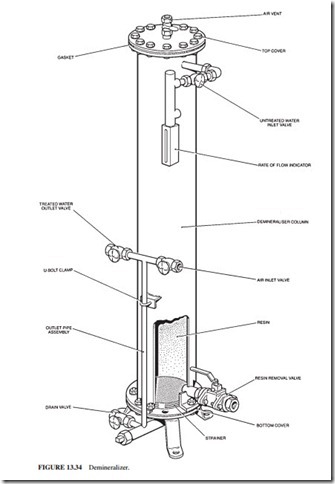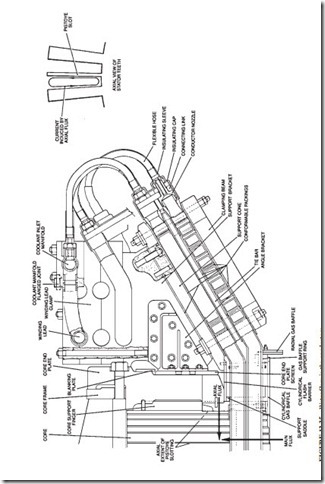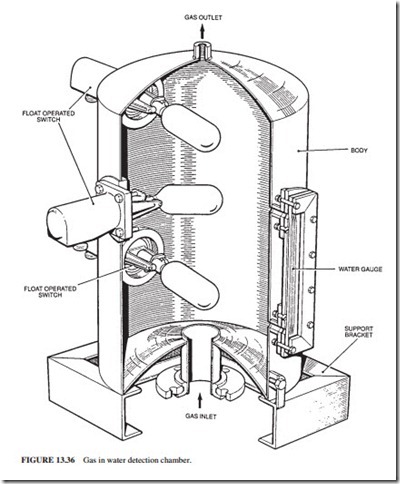STATOR WINDING WATER COOLING SYSTEMS
Figure 13.33 illustrates the demineralized water system used to remove the heat from the stator bars. The main criteria are as follows:
1. Very low conductivity prevents current flow and electrical flashover.
2. High-integrity insulation is used to transfer water into the conductors.
3. Low water velocity prevents erosion. Corrosion must also be prevented. Erosion or cor- rosion could result in a buildup of conducting material, leading to an electrical flashover.
4. The maximum water pressure must be lower than the hydrogen pressure. If leakage occurs, the hydrogen enters the water circuit. If water is allowed to enter the hydrogen, the winding insulation could be damaged.
5. The maximum water temperature should be well below saturation (boiling occurs at 115°C at system pressure) to ensure adequate heat removal capability. The normal inlet and outlet temperatures are around 40 and 67°C, respectively.
A portion of the water is circulated through a demineralizer (Fig. 13.34). All the met- als in contact with the water are nonferrous or stainless steel. If the metals have even a small amount of ferrous materials, magnetite will form. They will be held by electro- magnetic forces. The water flows in flexible translucent hoses made of PTFE (poly- tetrafluorethylene) into and out of the conductors (Fig. 13.35). In the double-pass design, the water supply enters a circular manifold. The manifold is supported from the stator core end plate. PTFE hoses are used to connect the manifold to the bars and between the top and bottom bars. The water flows in parallel channels in these bars. At the exciter end, the water is transferred through another PTFE hose to the outlet manifold. The inlet and outlet manifolds are located alongside each other. The terminal bushings and phase connections are cooled by a small flow. A higher pressure is required for the double- pass design compared with the single-pass design. However, only one-half of the number of hoses is needed. This reduces the chance of leakage. In the single-pass arrangement, the manifolds are at opposite ends. The water flows through the bars in parallel.
The water temperature rises rapidly if the flow is reduced. The differential pressure across an orifice plate or the stator windings is used to detect a reduction in flow. In this case, the standby pump should be started immediately, or the unit should be tripped.
An initial test is done on the water circuit to confirm it has a very low leak rate. However, a small quantity of hydrogen still enters the water. It is detected in a settling tank installed on the outlet side of the generator. Most of the gas is largely detrained in a header
Downloaded from Digital Engineering Library @ McGraw-Hill (www.digitalengineeringlibrary.com) Copyright © 2004 The McGraw-Hill Companies. All rights reserved.
Any use is subject to the Terms of Use as given at the website.
tank. The gas is collected in a chamber equipped with timed-release valves. An alarm is initiated if the release rate exceeds a predetermined level (Fig. 13.36).
Thermocouples are installed in each of the winding slots. They detect low-flow conditions. Modern machines have a thermocouple in each outlet hose. They provide a direct indication of low flow. As noted earlier, condensation should not occur on the windings. Some generators have an electric heating element. Other designs have an automatic cooler bypassing system. It prevents cold water from circulating in the windings during start-up and low-load conditions.



